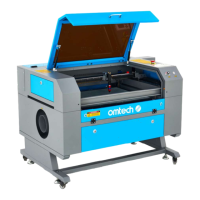23
same problem, so medium to low resolution designs should be preferred for most plastics.
Rubber
The various compositions and densities of rubber cause slightly varying engraving depth. Testing various settings on
sample pieces of your specifi c rubber is highly recommended for best results. When engraving rubber, generally use
a consistent high power setting and create your eff ects by varying the laser's speed. Microporous rubber materials
require a signifi cantly higher speed than standard rubber. Engraving any kind of rubber produces a considerable
amount of dust and gas. Depending on the amount of work, breathing PPE and/or a full ventilation system may be
required to address the problem.
Stone
When engraving various kinds of stone, generally use moderate power and moderate to fast speed. As with ceramics
and glass, be mindful of the dust created (especially for repetitive industrial applications) and take similar measures
to ensure the safety of users and others in the work area.
Textiles
When engraving textiles like cloth and fl eece, generally use low power and fast speed. As with leather, be especially
attentive to the possibility of fi re and dust.
Wood
As with rubber, there is a huge variety of woods and testing your specifi c material is essential to get the best results.
In general, wood with consistent grain and coloring engraves more evenly. Knotted wood produces uneven eff ects,
while resinous wood produces greater edge contrast. Some soft woods like balsa, cork, and pine engrave well (albeit
with low contrast) at low or moderate power settings and high speed. Others like fi r suff er from uneven fi bers that
usually produce a poor eff ect no matter what you do. Hard woods like cherry and oak engrave well at high power
settings and low speed. Manufactured wood products can vary from brand to brand, mostly based on its glue
composition and abundance. MDF works well but creates dark edges when cut.
In addition to the risk of fi re with any wood product, extra care must be taken with the fumes from the glue used
in plywood and other manufactured woods. Some are too dangerous to work with at all, while others require
careful ventilation and the use of breathing PPE for repetitive industrial applications. Wood toxicity should also
be examined, as the dust from some natural woods including oleander and yew can also cause nausea and cardiac
problems in high enough amounts.
Average Cutting Settings for Acrylic
Average Cutting Settings for Baltic Birch
Description 1/16 in. 1/8 in. 1/4 in. 1/2 in. 3/4 in. 1 in.
80 W
Speed 25 mm/s 12 mm/s 6 mm/s 4 mm/s 3 mm/s 1 mm/s
Power 18% 25% 35% 45% 55% 60%
Description 1/16 in. 1/8 in. 1/4 in. 1/2 in. 3/4 in. 1 in.
80 W
Speed 25 mm/s 12 mm/s 7 mm/s 5 mm/s 4 mm/s 3 mm/s
Power 20% 25% 30% 35% 43% 47%

